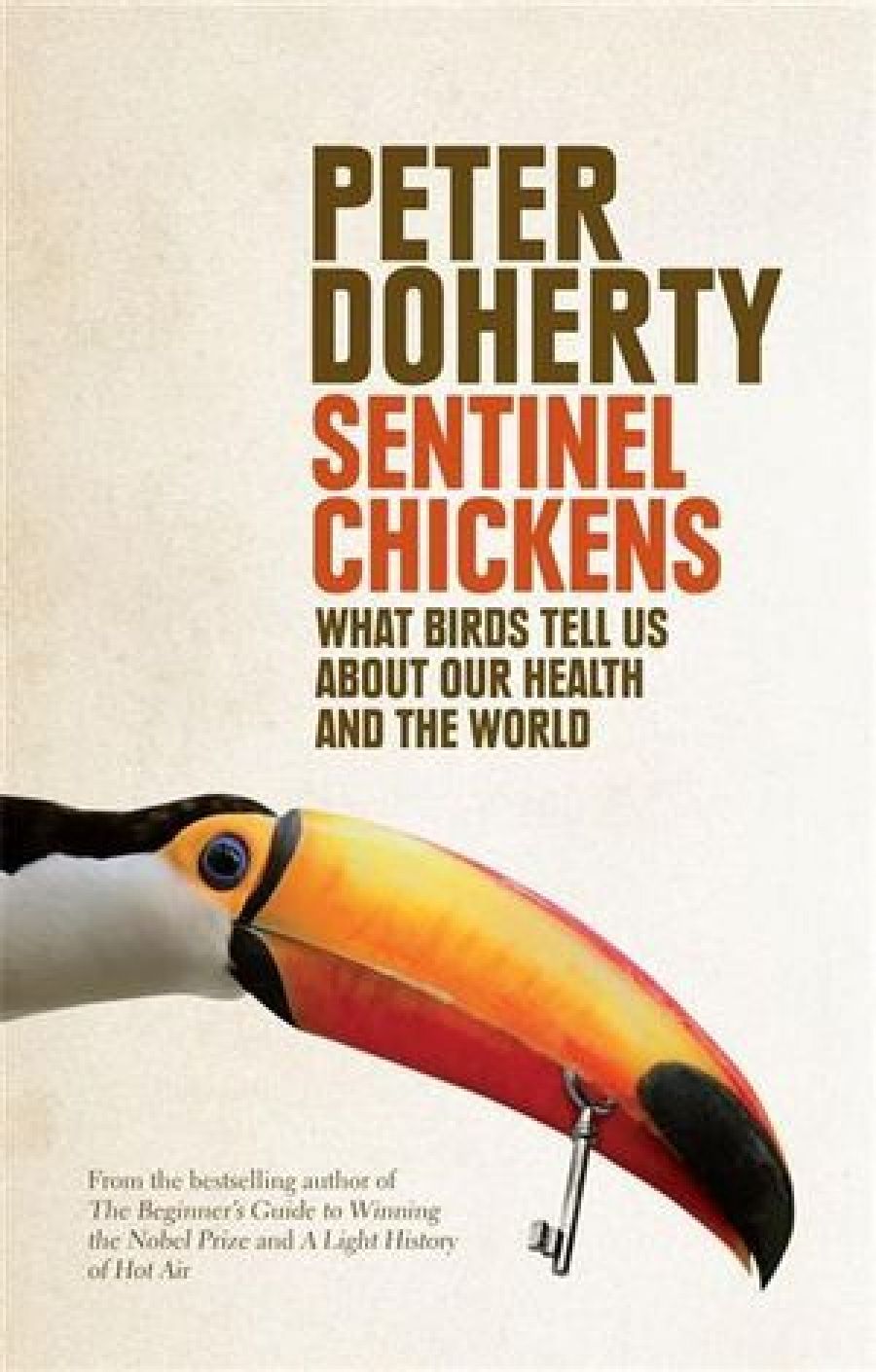
- Free Article: No
- Contents Category: Ornithology
- Review Article: Yes
- Online Only: No
- Custom Highlight Text:
Why would a famous virologist and immunologist (and Nobel laureate) write a book linking birds, human diseases, and ecological degradation? The answer is partly that Peter Doherty obviously has a soft spot for birds and birdwatching. He argues that anyone with an enquiring mind and a natural history ...
- Book 1 Title: Sentinel Chickens
- Book 1 Subtitle: What Birds Tell Us about Our Health and the World
- Book 1 Biblio: Melbourne University Press, $29.99 pb, 231 pp, 9780522861105
The beguiling image of sentinel chickens (caged chickens used to monitor the spread of viral diseases such as Ross River virus and Murray Valley encephalitis) is used as bait to capture our attention and launch into a sweeping tour of the value of birds to our civilisation and the threats they face. Each chapter is effectively an essay about a medical research theme in which birds feature, or a conservation theme that emphasises the interconnections between science and culture. Together these essays form an eclectic and fascinating collection, covering, for example, why canaries are better at detecting dangerous gases in coal mines than are mammals such as ourselves; why domestic ducks and chickens in Asia harbour influenza viruses and how these may suddenly spread; how lead pellets used in shotgun cartridges are poisoning wetlands; how a veterinary drug used to treat cattle in India caused a dramatic decline in vulture populations and the cultural ramifications of this; how over-fishing of a Caribbean shellfish has caused a switch in the shellfish market that now threatens a migratory shorebird population in Delaware Bay; and how the unintentional introduction of avian malaria to the Hawaiian Islands caused a cascade of bird extinctions.
Doherty begins by describing his personal conversion to birdwatching on a tourist cruise along the Canadian coast where he was charmed by Tufted Puffins and awed by Bald Eagles. He describes how he has come to the realisation that birdwatchers are ideally placed to be transformed into citizen scientists. This idea is well established in bird-monitoring programs organised at national or even continental scales by birding organisations worldwide: for example, Birdlife Australia’s bird atlas project, where volunteer birders collect information on bird presence and abundance in a systematic, predetermined way, and submit it to a national database.
A short history of virology, and the key players in its formative era, highlights the role of chickens and their eggs in the study of viruses. This leads to discussion of influenza and the role of birds as carriers of this most dangerous group of viruses, but also how birds have been critical as research tools in the decades-long search for understanding and control. Doherty touches on the dilemmas produced by the rapidly expanding human population of our planet. In order to feed burgeoning populations, many developing countries are intensively farming chickens, ducks, and pigs. A warm, wet climate, combined with intensive, poorly regulated livestock management, creates a perfect environment for the development and mutation of viruses and other disease organisms. It is inevitable that some of these, such as influenza A viruses, will produce mutations allowing them to infect other species, including humans, with potentially disastrous consequences.
The story of the decline of vultures in India and Pakistan is particularly arresting. The widespread use of a cheap, anti-inflammatory drug to treat cattle caused vultures that fed on dead cattle to suffer a life-ending form of gout. Fewer vultures resulted in increased populations of other scavengers, including wild dogs that carry rabies. It is estimated that human deaths caused by rabies increased by 50,000 as a consequence of the decline of the vulture population.
Some of the material covered is complex, particularly that pertaining to research that uncovered the variety of influenza viruses and how they propagate and are spread. However, more than twenty pages of notes and a detailed reference section come to the rescue.
The book culminates in a succinct plea for a fundamental shift in our way of life, combined with careful scientific enquiry, to reduce the chance of impending ecological disaster for fauna and humans alike. Doherty emphasises that many threats to birds are neither obvious nor widely understood. While disasters such as oil spills provide graphic images, there are often far less spectacular forces that drive population declines and eventual extinctions. Slow and hidden processes are the real killers, such as the incremental loss and fragmentation of habitat, the steady degradation of habitat quality, and climate change. Doherty’s statements about anthropogenic climate change in the final two chapters are refreshingly clear, concise, and sensible. He concludes: ‘In so many respects, our failure to limit CO2 emissions causes ever-increasing damage to the web of life that nurtures the birds, and ultimately, us. Is there a more important issue facing humanity?’ Coming from a leading medical researcher, who has spent a lifetime thinking deeply about human diseases and human population demography, this is indeed a powerful statement.


Comments powered by CComment